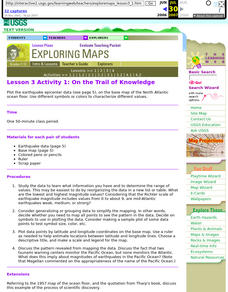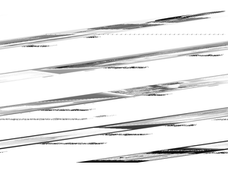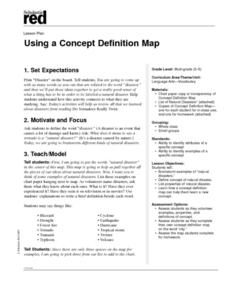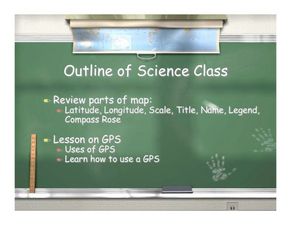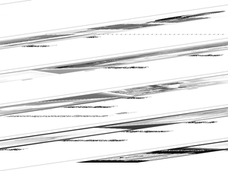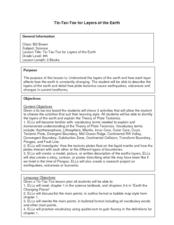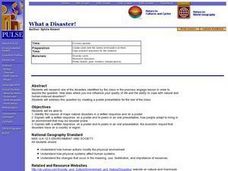Kenan Fellows
Making Connections with Water Quality
What's in your water? And, why is water quality so important? Enhance your class's level of water appreciation through a lesson that demonstrates the necessity of water quality. Environmental enthusiasts explore the EPA's Clean Water...
Curated OER
Learning from history: can it save lives?
Students research and document lessons learned from this disaster, then compile and synthesize information. They write effectively for public education purposes and use visual communications tools
Curated OER
Lesson 3 Activity 1: On the Trail of Knowledge
Students plot the earthquake epicenter data on the base map of the North Atlantic ocean floor using different symbols or colors to characterize different values.
Curated OER
World's Most Dynamic Force
Students explore the Earth's forces. They review an assessment task and its accompanying rubric. They classify ten items as long-term or short-term interactions of the Earth's components and rank the destructive impact of the forces. ...
Alabama Learning Exchange
Are You Prepared?
Pupils research specific natural disasters using the Internet and a collection of books. The natural disasters include; floods, hurricanes, tornadoes, tsunamis, winter stroms, wildfires, thunderstorms, volcanoes, and earthquakes. They...
NASA
Erosion and Landslides
A professional-quality PowerPoint, which includes links to footage of actual landslides in action, opens this moving lesson. Viewers learn what conditions lead to erosion and land giving way. They simulate landslides with a variety of...
Curated OER
Slush Rush
Students navigate software to help students understand the benefits of computer models. In this computer models lesson, students use computer inquiry tools to record simulated events and how they affect objects such as houses or...
NASA
Hurricanes and Hot Towers with TRMM
Take cover because a wild presentation on hurricanes is about to make landfall in your classroom! An outstanding PowerPoint presentation is the centerpiece of this lesson. Not only does it provide information and photographs, but several...
NOAA
Currents
A deep ocean current circles the globe at a force that is greater than 16 times all the world's rivers combined. Groups analyze the effects of submarine topography on deep ocean current speed. They then determine how this speed affects...
Curated OER
Natural Disasters
Students work together in groups to travel throughout the room to different stations. They practice making different natural disasters at each station. They also examine fault lines and the supercontinent Pangaea.
Curated OER
The Tell-Tale Plume
Students examine hydrothermal vents. In this ocean lesson, students identify changes in physical and chemical properties of sea water caused by hydrothermal vents.
Curated OER
Using a Concept Definition Map
Students define "natural disaster" by offering examples and charting them to discover what a concept definition map is. Then students create their own maps using the word "city".
Curated OER
Science Videos
Students plan, practice, and act in a 2-3 minute videotaped production about a specific topic. Students from a local high school give presentations pertaining to seasons, earth rotation, and moon phases. Students analyze the...
Curated OER
Lesson on GPS
Students investigate global positioning systems. In this technology and mapping lesson, students view a PowerPoint presentation in which they identify the features of a GPS, state its uses, and follow steps to find a waypoint.
Curated OER
Help I've Fallen And I Can't Get Up
Young scholars examine how natural disasters impact humans and how to develop a disaster relief plan. They develop a list of natural disasters, and in disaster relief teams, create an emergency plan for their families to follow if a...
Curated OER
The Chemosynthetic Cafe
Students study photosynthesis and chemosynthesis. In this chemosynthetic lesson students explain the processes of these and define terms.
Curated OER
Where is Everyone Going?
Students conduct an experiment. In this emergency response lesson, students watch videos about hurricanes and discuss the difference between natural disasters and man-made disasters. Students perform a hurricane demonstration and...
Curated OER
Keeping Our Pets Safe In An Emergency
Young scholars fill out worksheets that teach them how to prepare for emergency situations and how to enable animal safety in emergency situations. In this emergency lesson plan, students talk about different kinds of emergencies and how...
Curated OER
Social Studies: Exploring Japan
Fourth graders examine the culture and environment of Japan, beginning with a KWL chart. They use clay and cups of water to construct representations of the Japanese Islands. After designing flags representing farming and food, 4th...
Curated OER
Tic-Tac-Toe for Layers of the Earth
Eighth graders identify the different layers of the earth. In this earth science activity, 8th graders choose a project to do from a given list according to their learning style. They present their finished project in class.
Curated OER
The Philippines-U.S. Involvement
Pupils research and discuss the rational for U.S. involvement in the Philippines. They discuss overall foreign and domestic policies of the U.S. Then they create a timeline that highlights this impact.
Curated OER
What a Disaster!
High schoolers identify the causes of major natural disasters in a written response and on a poster. They explain with a written response, on a poster and to peers in an oral presentation, how people adapt to living in an environment...
Science Education Resource Center at Carleton College
Serc: The 2004 Sumatra Earthquake and Tsunami
Using real seismic recordings from a number of seismic stations, learners find the location of the epicenter of the 2004 Sumatra earthquake. They next determine the path of the tsunami triggered by it, and calculate how much lead time...
Science Education Resource Center at Carleton College
Serc: 2004 Asian Earthquake and Tsunami Disaster Project
Students are employees of a unit of the United Nations responsible for coordinating disaster relief after a major disaster (the 2004 Asian Earthquake and Tsunami) occurs. The agency needs to understand the situation in each country so...




